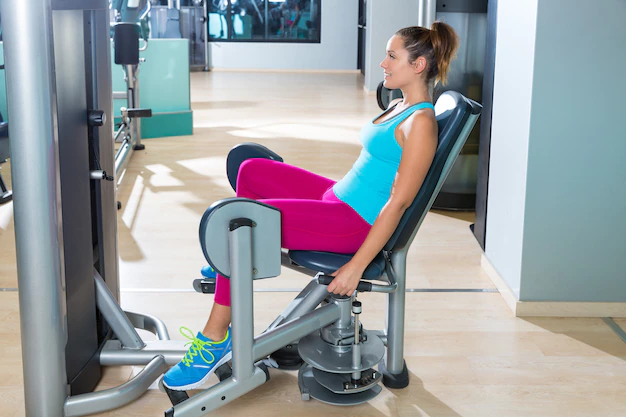A abdução de pernas na máquina é um exercício clássico para fortalecer os abdutores das coxas.
Existem muitas formas de trabalhar o músculo abdutor (parte externa da coxa), mas na máquina é possível estimulá-lo de forma isolada e com mais segurança.
Em algumas máquinas também é possível fazer a adução. É o caso da cadeira abdutora e adutora que permite a prática não só da abdução mas também da adução das pernas. Dessa forma, são trabalhados tanto os músculos externos quanto os internos da coxa.

O fortalecimento desses pequenos músculos pode ser bom para outros exercícios como o levantamento deadlift e o agachamento.
Mesmo sendo um grupo muscular relativamente pequeno composto por glúteo médio, glúteo mínimo e tensor da fáscia lata, os abdutores são muito usados no dia a dia. De fato, eles participam de movimentos em que é preciso abrir ou girar as pernas e quadris (como ao sair de um carro, por exemplo) e ainda ajudam a melhorar a estabilidade dos quadris, a aumentar a flexibilidade das articulações da região pélvica e a prevenir dores e lesões locais.
Como fazer abdução de pernas na máquina

Sente-se no banco da máquina e apoie bem as costas. Em seguida, posicione as pernas no equipamento com as partes externas das coxas encostadas nas almofadas.
Apoie as mãos ao lado do corpo e comece o exercício empurrando as almofadas para fora. Para isso, você deve abrir as pernas fazendo força para fora. Retorne à posição inicial fechando as pernas em um movimento lento e controlado.
Você pode fazer 3 séries de 8 a 12 repetições ou seguir a orientação de um professor de educação física.
Erros comuns

Veja os erros mais comuns que você pode evitar no seu treino de abdutores na máquina.
Exagerar na amplitude de movimento
A facilidade no uso da máquina pode te levar a exagerar na amplitude. Apesar de ser bom para o músculo, o exagero pode causar dores na coluna ou nos quadris e ate mesmo lesões.
Desta forma, o melhor mesmo é respeitar os seus limites e diminuir a amplitude de movimento na cadeira abdutora ou interromper a atividade ao sentir qualquer tipo de desconforto.
Usar muito peso
Colocar carga demais pode sobrecarregar os abdutores, que são músculos pequenos e sensíveis. Portanto, evite exageros na hora do treino na cadeira abdutora.
Terminar as séries muito rápido
Abrir e fechar as pernas muito rapidamente prejudica o seu rendimento no exercício além de aumentar o risco de lesões. Assim, prefira fazer movimentos controlados e lentos para ter um treino satisfatório e seguro.
Fontes e referências adicionais
- Effects of a 12-week hip abduction exercise program on the electromyographic activity of hip and knee muscles of women with patellofemoral pain: A pilot study, 2020, Motriz: Rev. Educ. Fís., 26 (1).
- Hip abduction machine is better than free weights to target the gluteus medius while minimizing tensor fascia latae activation, Journal of Bodywork and Movement Therapies, 2022, Volume 30, Pages 160-167.
- An examination of the gluteal muscle activity associated with dynamic hip abduction and hip external rotation exercise: a systematic review, Int J Sports Phys Ther. 2015 Oct; 10(5): 573–591.
- Perceived loading and muscle activity during hip strengthening exercises: comparison of elastic resistance and machine exercises, Int J Sports Phys Ther., 2013 Dec; 8(6): 811–819.
- Hip and Groin Injury Prevention in Elite Athletes and Team Sport – Current Challenges and Opportunities, Int J Sports Phys Ther., 2021; 16(1): 270–281.
- On the importance of the hip abductors during a clinical one legged balance test: A theoretical study, PLoS One, 2020.
- Evaluation of hip abductor and adductor strength in the elderly: a reliability study. 2017, Eur Rev Aging Phys Act 14, 5.
- Hip Abductor and Adductor Rate of Torque Development and Muscle Activation, but Not Muscle Size, Are Associated With Functional Performance, Front. Physiol., 2021, 14.
- Changes in Knee Biomechanics After a Hip-Abductor Strengthening Protocol for Runners With Patellofemoral Pain Syndrome, J Athl Train. 2011; 46(2): 142–149.
- Hip Abductor Function and Lower Extremity Landing Kinematics: Sex Differences, J Athl Train., 2007; 42(1): 76–83.
- Hip abductor weakness in distance runners with iliotibial band syndrome. Clin J Sport Med. 2000; 10(3): 169-75.
- A randomised trial into the effect of an isolated hip abductor strengthening programme and a functional motor control programme on knee kinematics and hip muscle strength. 2015, BMC Musculoskelet Disord 16, 105.
Fontes e referências adicionais
- Effects of a 12-week hip abduction exercise program on the electromyographic activity of hip and knee muscles of women with patellofemoral pain: A pilot study, 2020, Motriz: Rev. Educ. Fís., 26 (1).
- Hip abduction machine is better than free weights to target the gluteus medius while minimizing tensor fascia latae activation, Journal of Bodywork and Movement Therapies, 2022, Volume 30, Pages 160-167.
- An examination of the gluteal muscle activity associated with dynamic hip abduction and hip external rotation exercise: a systematic review, Int J Sports Phys Ther. 2015 Oct; 10(5): 573–591.
- Perceived loading and muscle activity during hip strengthening exercises: comparison of elastic resistance and machine exercises, Int J Sports Phys Ther., 2013 Dec; 8(6): 811–819.
- Hip and Groin Injury Prevention in Elite Athletes and Team Sport – Current Challenges and Opportunities, Int J Sports Phys Ther., 2021; 16(1): 270–281.
- On the importance of the hip abductors during a clinical one legged balance test: A theoretical study, PLoS One, 2020.
- Evaluation of hip abductor and adductor strength in the elderly: a reliability study. 2017, Eur Rev Aging Phys Act 14, 5.
- Hip Abductor and Adductor Rate of Torque Development and Muscle Activation, but Not Muscle Size, Are Associated With Functional Performance, Front. Physiol., 2021, 14.
- Changes in Knee Biomechanics After a Hip-Abductor Strengthening Protocol for Runners With Patellofemoral Pain Syndrome, J Athl Train. 2011; 46(2): 142–149.
- Hip Abductor Function and Lower Extremity Landing Kinematics: Sex Differences, J Athl Train., 2007; 42(1): 76–83.
- Hip abductor weakness in distance runners with iliotibial band syndrome. Clin J Sport Med. 2000; 10(3): 169-75.
- A randomised trial into the effect of an isolated hip abductor strengthening programme and a functional motor control programme on knee kinematics and hip muscle strength. 2015, BMC Musculoskelet Disord 16, 105.








